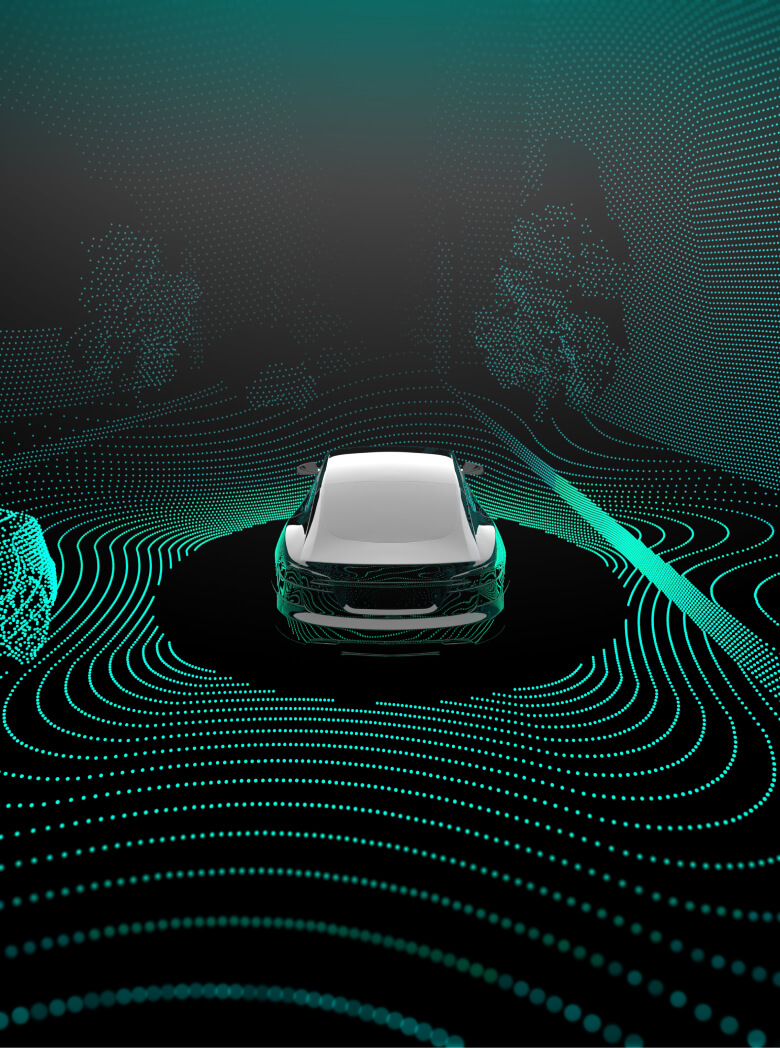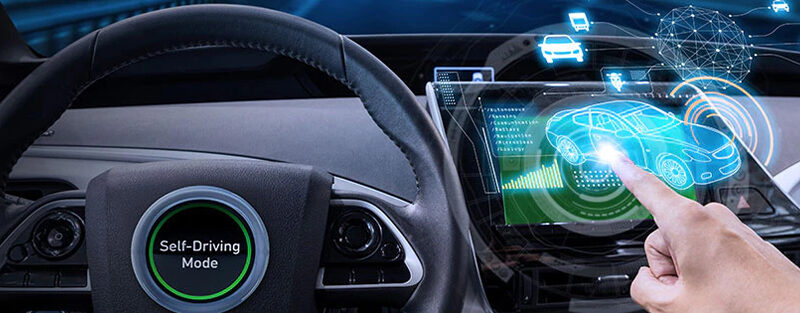High-tech features offer both safety and hazards
Vehicle technologies like front collision warning and automatic emergency braking are proven to reduce accidents. However, other technology, such as infotainment systems, can easily distract drivers, offsetting the benefits that newer safety features offer. Experts also say that the lack of standardized names can make it difficult to know what features a vehicle has and how they work. This culminates in a vehicle technology landscape that can make driving safer in some ways, but less safe in others.
Real-world data changes the game for automobile safety innovations
Ten years ago, the Insurance Institute for Highway Safety (IIHS) released some game-changing numbers that showed front collision warning, lane departure warning, blind-spot monitoring, and curve-adaptive headlights together could prevent or mitigate nearly one-third of reported crashes each year. Further research showed that front collision warning with automatic braking could prevent rear-end collisions. And not just a few crashes — half of them.
The Highway Loss Data Institute (HLDI) and its sister organization, IIHS, took this data and, with the National Highway Traffic Safety Administration (NHTSA), brokered an agreement with automakers. Twenty manufacturers, representing 99% of the U.S. car market, agreed to equip at least 95% of new cars and light-duty trucks with automatic emergency braking by 2022.
Although the agreement aims to reduce accidents for drivers, the full commitment will not be met by 2022. Only about 8% of cars on the road were equipped with front automatic braking in 2019, and it’s estimated that only 25% to 30% will be fully equipped by 2024.
As front collision and automatic braking slowly make their way into new cars, other technology is also becoming standard — but it’s not having the same impact on safety. Some of the most common technology in cars, like infotainment systems, might actually facilitate unsafe habits.

Four car technologies that supercharge safety
According to a 2020 HLDI analysis of police-reported crashes and insurance claims, front collision warning systems help reduce front-to-rear crashes by 27%, while front collision warning with emergency autobraking cuts front-to-rear crashes by 50%. These are big numbers, says Matt Moore, senior vice president of the Highway Loss Data Institute (HLDI). He also notes a few other systems that improve driver safety, namely blind-spot warning systems, rear auto braking, and automatic high beams.

1. Front automatic emergency braking*(See Disclosure)
Reduces front-to-rear crashes by 50%
Moore says there are a couple reasons why automatic emergency braking (AEB) is so effective. One is that front AEB specifically is designed to reduce the most common type of collision: front-to-rear car crashes. The second reason is that people trust the technology.
A HLDI study showed that when cars are brought in for service, AEB systems were almost always left on by drivers, while lane departure warning systems were turned off about half the time.
“If you’re in a situation where you’re about to rear-end somebody, your natural reaction is to grab the steering wheel, hold steady, and stand on the brake. And that’s pretty much what the vehicle does for you [with automatic emergency braking]. But if you’re going 60 miles an hour around a curve and the car starts yelling at you, what are you supposed to do? I think that’s one of the limitations with the lane departure warning system — we’re relying on the driver to take appropriate action, and every situation is different,” says Matt Moore.
Ashwin Kekre, a product development manager at Progressive, says Progressive is able to offer a discount for vehicles with automatic emergency braking**(See Disclosure) because the data from HLDI has been so game changing.
“[We can’t offer a discount] unless we can prove to the Department of Insurance in every state that we have data to support the use of the technology,” he says. “It took us some time to get that discount into our product, but it was certainly something we had been working on ever since HLDI proved with their analysis that this technology was really effective in reducing accidents.”

2. Blind-spot warning (BSW)*(See Disclosure)
Reduces lane-change crashes by 14% & crashes with injuries by 23%
Another effective crash avoidance system is blind-spot warning (BSW), which alerts drivers when another vehicle is in the next lane but can’t be seen in the rearview and side mirrors. HLDI estimates that BSW reduces lane-change crashes by 14% and lane change crashes with injuries by 23%.
Kekre points out that blind-spot warning is important because it increases the driver’s circle of safety, providing an alert for what’s happening on each side of the vehicle and helping prevent side swipes and crashes.
Consumer Reports considers automatic emergency braking, front collision warning, and blind-spot warning the top three must-have safety features for buyers of new cars.

3. Rear cross-traffic warning & rear auto emergency braking
Reduces backing crashes by 78%
Rear cross-traffic alerts (RCTA) have proven to be more effective than rearview cameras in preventing backing crashes — an estimated 22% reduction vs. 17% for rearview cameras. RCTA systems use sensors to alert drivers when a car or object is approaching from the side, while a rearview camera simply provides a better backup view than rear and side mirrors.
Although rear cross-traffic alerts are useful, the most effective tech for reducing backing crashes is rear automatic emergency braking. When combined with rearview camera and parking sensors, rear automatic braking is estimated to reduce backing crashes by a whopping 78%.
Additionally, Moore says rear automatic emergency braking (AEB) shows a significant reduction in property damage liability claims — over 28% — evidence that the technology prevents back-up crashes.
The big difference between front and rear auto braking is the lives saved, says Moore. Front AEB prevents more collisions between cars, while rear AEB prevents smaller collisions, usually with stationary objects.

4. Automatic high beams & related tech
Higher-rated headlights reduce single-vehicle nighttime crashes by ~20%
Automatic high beams are considered a feature worth having by many organizations, including IIHS and Consumer Reports. IIHS began rating headlights in 2016 as part of its safety assessments and found that vehicles with higher-rated headlights had nearly 20% fewer single-vehicle nighttime crashes than those with poor-rated headlights.
IIHS reports that high beam assist, where the car automatically turns high beams (also known as “brights”) on and off, is not in enough cars to measure its overall effectiveness at reducing crashes. But one analysis found that high beam lights are significantly underused — only 18% of drivers included in the study used them. Automatic high beam systems take over the task of turning high beams on and off, which HLDI says could improve high beam usage and increase nighttime visibility for drivers.
Another innovation is curve-adaptive headlights, which illuminate the road in front of you, even when you’re going around curves. A study by HLDI found that cars equipped with these headlights saw a 5.8% reduction in property damage liability claims and a 1.1% reduction in collision claims. That’s not nearly as impactful as front collision warning and automatic emergency braking, but it’s still a noticeable increase in safety that, when combined with other driver assistance features, could prevent even more accidents at night.

Three car technologies that can create distractions
Not all new car technology is safety focused. Some features are designed more for convenience than safety, like infotainment systems, auto-dimming mirrors, keyless entry, Wi-Fi hotspots, Bluetooth, and head-up displays.
But how do some of these convenience features impact safety? It depends on the feature and how much it distracts the driver.

1. Hands-free Bluetooth phone calls
Hands-free calls don’t free up the mind
Bluetooth-enabled hands-free phone calls have resulted in a decrease in drivers using their phones manually. The National Highway Traffic Safety Administration (NHTSA) found that the percentage of drivers talking on handheld phones decreased from 2.9% in 2019 to 2.6% in 2020. What’s interesting about this data is that researchers cannot detect when drivers are using their cars’ hands-free system.
However, data from Progressive‘s Snapshot program, which uses an app or plug-in device to personalize car insurance rates based on driving habits, found that 99% of enrolled drivers used their phone at least once while driving in 2020. If studies show that only a small percentage of drivers are seen using handheld phones, it’s a safe bet that many of them were making calls using hands-free technology.
While this tech might allow drivers to keep their eyes on the road while using the phone, David Strayer, a professor of cognition and neural science at the University of Utah who runs the Applied Cognition Lab and conducts distracted driving research for AAA, says a phone call is a phone call, and it takes the same amount of mental effort.
“The only thing you might see a benefit for, possibly, is if the dialing parts don’t require manually pushing buttons. But the hands-free kits don’t free up the mind. If you’re carrying on a conversation, that’s just as distracting if it’s a handheld or a hands-free device,” says Strayer.
“How many people are doing that and going right by their exit?” he adds. “If you drove by your exit, what else could you miss? Maybe it’s something that’s really critical, and maybe it isn’t. That’s the problem, you can get away with a lot of this stuff until you can’t.”

2. Head-up display systems
Projected info can distract
Another convenience feature that’s becoming more common, head-up display (HUD) systems project information, like speed and fuel, onto the windshield. Manufacturers claim that this tech reduces distraction and keeps drivers’ eyes on the road.
Strayer says that may very well be the case, but it depends on what’s being displayed. “Sometimes they’ll have collision or blind-spot warnings with this kind of display to let you know about some potential hazard, and that’s useful,” he says. “But if it’s presenting a text, or you’re trying to send some text message?” That’s a dangerous distraction. He says drivers should use this technology judiciously and in support of driving — not for entertainment purposes.

3. In-vehicle infotainment systems
Complicated tasks take eyes off the road
Speaking of entertainment, in-vehicle infotainment systems (IVIS) have become bigger and flashier in recent years. These elaborate in-dash systems allow drivers to access navigation maps and phone operations. They’re also increasingly replacing the knobs and dials used for radios, climate control, and other car features. In a vehicle with a touchscreen, changing the radio station or turning up the A/C can require more movements than just the turn of a knob.
Strayer’s studies for AAA have assessed driver distraction while doing tasks like changing the radio station, inputting a route into the navigation system, and placing a phone call. He says the level of distraction for the driver varies based on the car’s system, and many times it’s off the charts.
“Some of the cars we tested had over 200 multifunction buttons, one or more touchscreens, voice commands, head-up displays. The modern car looks like a jet fighter with all the displays. Some cars even allow you to play games on the screens while you’re driving,” says Strayer.
Disabling features & using familiar systems can help
Strayer believes manufacturers should follow NHTSA’s guidelines and disable a lot of these features while the car is in motion to prevent people from trying to use them while driving.
Distracted driving is blamed for 8.7% of all car crash fatalities in 2019, according to NHTSA. It’s no wonder that organizations like AAA are researching how infotainment systems affect drivers. Strayer’s team found that making a phone call and changing the audio settings took the least amount of attention from the driver, while inputting information into the navigation system required more than double the attention.
And it was worse for systems designed by automakers themselves. The better option, according to Strayer, is using the interfaces you’re already accustomed to — ones like Apple’s CarPlay and Android Auto. These interfaces allow you to plug your Apple or Android phone into the car’s system and access some of the phone’s features on the car’s screen. You can even use Google Assistant or Siri voice commands to control music and navigation. Since Apple first introduced CarPlay in 2014, the company says every major automaker has models that support CarPlay. And if they support CarPlay, they generally support Android Auto too.
“The truth is that both Google and Apple have been working for 20 years or so on good user interfaces that are easy to use,” Strayer says. “So there’s a look and feel that we’re already familiar with. The car companies just don’t have the resources to be able to make their own version that’s as easy and intuitive to use.”

Safety ultimately lies with the driver
Regardless of the interface, though, drivers should be aware that making calls, sending texts, and setting up their maps can distract them from the task at hand — getting to their destination safely. And their cars, no matter what safety tech they’re equipped with, might not be able to save them from a collision.
Car tech names and functions can easily confuse
While front collision warning and automatic braking are easy concepts for drivers to understand, it can be challenging to figure out if a vehicle has these systems. And it doesn’t help that manufacturers don’t call these features by the same names.
It starts with confusing names
One of the biggest factors confusing drivers is what the tech systems are called and how they work, according to a coalition that includes Consumer Reports, J.D. Power, and the National Safety Council. So far, this group says, manufacturers have taken a marketing approach to naming the features in their vehicles, which is creating confusion among consumers.
For instance, Toyota has Pre-Collision System, Full-Speed Range Dynamic Radar Cruise Control, and Lane Tracing Assist while Chevrolet calls the same type of systems completely different names with Forward Collision Alert, Adaptive Cruise Control, and Lane Change Alert with Side Blind Zone Alert.
“A lot of them can even have names like autopilot, which can be misleading. Trying to come up with some common nomenclature can help — what is Smart Grade (John Deere) versus City Safety (Volvo) versus automatic braking versus Honda Sensing? It can be very hard for the consumer to even understand what the car has and what it really does,” says Kekre.
The coalition came up with standardized names for tech safety systems that were endorsed by the Department of Transportation in January 2020. They hope automakers, journalists, and other organizations will adopt them to lessen confusion.
Some safety features confuse drivers, too
It’s not just the names that can confuse people. Sometimes the actual technology confuses people too, especially features like lane departure warning and adaptive cruise control.
Lane departure warning (LDW) can be unsettling
While LDW systems, sometimes called lane assist, seem straightforward, how they behave and what they expect the driver to do can be more alarming than helpful. As Matt Moore from HLDI described earlier, if you’re driving around a corner and your lane departure warning alerts, what are you supposed to do? What’s the correct action to take? Every situation is different, and not every driver has been taught the correct response.
When driving in a straight line on a highway, lane departure can provide valuable assistance. But not every system behaves the same way. Some cars just alert the driver that they’re crossing the line with a sound or a visual cue. Other cars will automatically steer the car back into the center of the lane, whether you want it to or not. If you’re passing a bicyclist on the side of the road or trying to avoid an animal, this automatic steering can feel like a dangerous intervention.

Adaptive cruise control can be easy to forget
Another promising technology that can confuse drivers is adaptive cruise control, which also goes by names like automatic, active, radar, and intelligent cruise control. Cars equipped with this technology use radar sensors and cameras to monitor your speed and your distance from other vehicles. Sounds great, particularly when you’re headed out on the road for a long trip.
The trouble comes when you’re not quite sure how to set it. “[Distance settings are] one of the things that often can make a person uncomfortable,” says Moore. “When your vehicle with adaptive cruise control is active, and it’s following the leading vehicle too closely, that’s a setting that can often be adjusted by the driver.”
Cognitive neuroscientist David Strayer says while adaptive cruise control is a promising safety feature, there are plenty of anecdotes of it going very wrong — and confusing drivers in the process.
“If you’re following a car and it takes an exit, all of a sudden your car accelerates,” says Strayer. “In fact, some of the unintended accelerations that people report are just because they programmed the car to go 50 miles an hour, and they’ve been following a car for 20 miles. And when that car changes lanes, all of a sudden, your car accelerates, and it’s like, whoa, what’s going on? And it’s because you programmed it, but you just didn’t remember programming it.”
An end to confusion?
When it comes to clearing up confusion about what your car can do, all our experts say one thing: Read the manual! “Make an effort to educate yourself about the vehicle and the things it can do and the things it can’t do,” says Moore.
Kekre agrees, saying drivers need to understand their responsibilities and not rely on the tech to do too much on their behalf. “It is truly important to understand [how these technologies work], especially when you’re going to entrust your life when you’re behind that steering wheel,” says Kekre.
You should also learn how different safety features alert you. Alerts can be audible, visual, or haptic — meaning your seat can rumble or vibrate. Most of these settings are customizable and can be turned off and on. You’ll want them to alert you in the most effective way to prompt an appropriate reaction to avoid a potential collision — and not confuse you behind the wheel.
Get even more peace of mind on the road
Get the customized protection you need at a price that works for you — online or through an agent. Drivers nationwide who switch and save with Progressive save over $700 on average.†(See Disclosure)
Technology can create safer roads
The current landscape of car tech and advanced safety systems might be a little confusing and sometimes distracting, but it’s also extremely promising. Some safety features, like front collision and automatic braking, are already reducing accidents by significant numbers. We can expect automakers to continue responding to data from organizations like HLDI and NHTSA and feedback from Consumer Reports and others to refine their technologies, improve their systems, and hopefully standardize their naming conventions to help consumers understand and embrace new safety features. In the future, we could see car accidents reduced to zero thanks to safety technology.

MATT MOOREHLDI, Senior Vice President
Matt Moore is senior vice president of the Highway Loss Data Institute. He oversees HLDI’s research program, the collection of vehicle information, and the production of loss data. HLDI processes insurance data from companies that represent approximately 85 percent of the U.S. private passenger auto insurance market.

ASHWIN KEKREProduct Development Manager, Progressive
Ashwin Kekre is a product development manager at Progressive.

DAVID STRAYERCognitive Neuroscientist, University of Utah
Dr. David Strayer is a professor in the Department of Psychology at the University of Utah and director for the Center for the Prevention of Distracted Driving. He conducts research for AAA and has given briefings to the U.S. House and Senate on distracted driving issues.

